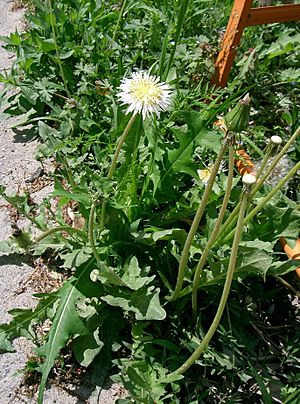Taraxacum albidum facts for kids
Quick facts for kids Taraxacum albidum |
|
|---|---|
 |
|
| White-flowered Japanese dandelion | |
| Scientific classification | |
| Genus: |
Taraxacum
|
| Species: |
albidum
|
Taraxacum albidum is a special kind of dandelion found in eastern Asia. It is a plant that grows back every year. This white-flowered dandelion is originally from southern Japan. It belongs to the Asteraceae family, which includes many daisy-like flowers.
Sometimes, people confuse it with Taraxacum coreanum. However, T. coreanum mostly grows in the Korean Peninsula and parts of China. Taraxacum albidum is a hybrid plant. This means it was formed by combining two different types of dandelions: T. coreanum and Taraxacum japonicum.
Contents
What It Looks Like
This dandelion has deep green leaves that grow in a circle close to the ground. From the center of these leaves, a smooth, hollow stem grows upwards. This stem can reach about 40 centimeters (1 foot 4 inches) tall.
Each stem holds one single flower head. This flower head is made of many small, white petals called florets. Before opening, the flower is a round bud with narrow green bracts around it.
How It Grows
Taraxacum albidum usually blooms once a year. This happens in the spring, from March to May. Sometimes, it might bloom again in late autumn.
This plant has five sets of chromosomes, which is unusual. It can make seeds without needing pollination. This process is called asexual reproduction. Most of its seeds are made this way. However, a few of its flowers do need pollination. This allows it to mix with other dandelion types.
Life Cycle
After the flower closes, it later opens again. It becomes the familiar fluffy seedhead, often called a "dandelion clock." This seedhead holds many tiny fruits, called achenes. Each achene has a pappus, which is a parachute-like tuft of fine hairs.
These hairs help the seeds fly away in the wind. This way, the seeds can travel far from the parent plant. The seeds then rest and do not grow until autumn.
During the hot summer months, the leaves of the plant dry up. This helps the plant avoid damage from the heat. In autumn, new leaves grow. These new leaves continue to make food through photosynthesis until the next summer.
See also
 In Spanish: Taraxacum albidum para niños
In Spanish: Taraxacum albidum para niños


